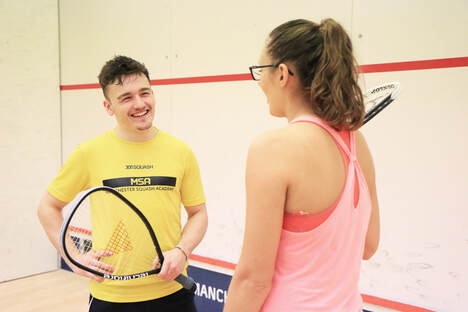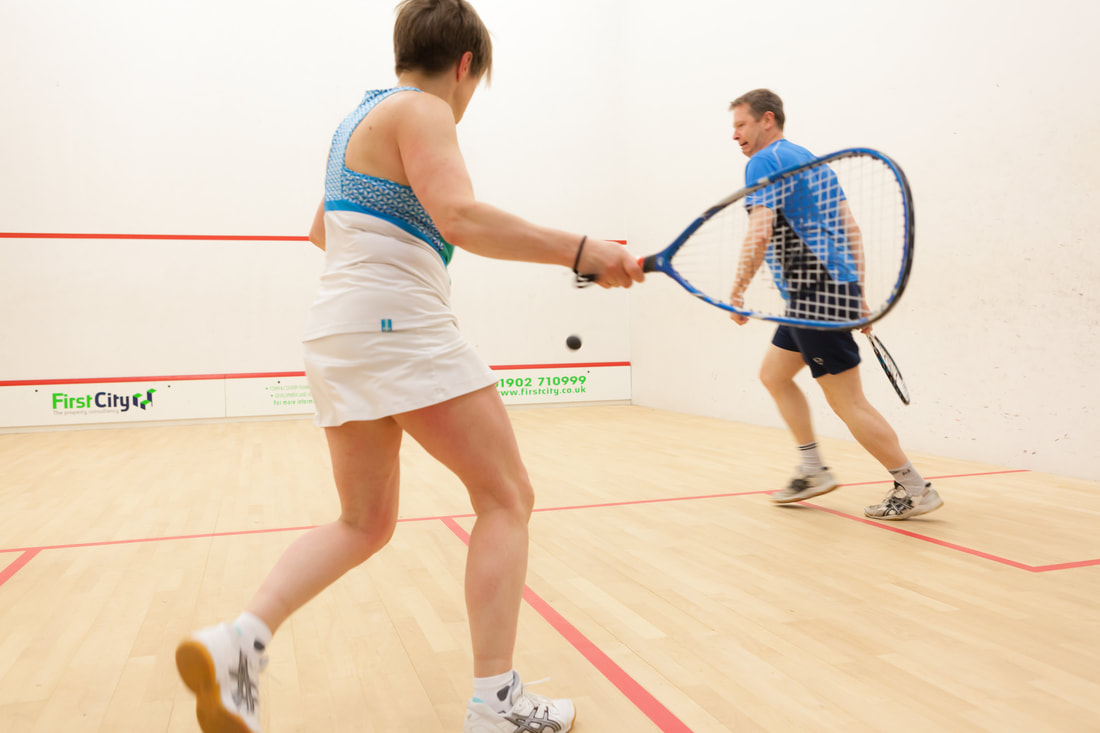
At the beginning of the match spin a racket. The winner of the racket spin starts the match as the server.
The server at the start of the game decides which side to begin service from. They will continue to serve until they lose a rally. At this point their opponent has won the serve and will continue to serve until they lose a rally and with it the serve.
For a “good” serve
You must have one foot inside the service box with no part of that foot touching the red line.
You must bounce the ball before you strike it. After the ball has bounced on the floor it must be struck before it bounces twice or touches a wall.
The ball must hit the front wall before striking any other walls
The ball must hit the front wall above the tin and not hit any wall above the out of court line.
Second Serve/a fault if…
The server at the start of the game decides which side to begin service from. They will continue to serve until they lose a rally. At this point their opponent has won the serve and will continue to serve until they lose a rally and with it the serve.
For a “good” serve
You must have one foot inside the service box with no part of that foot touching the red line.
You must bounce the ball before you strike it. After the ball has bounced on the floor it must be struck before it bounces twice or touches a wall.
The ball must hit the front wall before striking any other walls
The ball must hit the front wall above the tin and not hit any wall above the out of court line.
Second Serve/a fault if…
- At the time of striking the ball the server fails to have at least one foot in contact with the floor within the service box. No part of this foot can touch the service box line.
- The ball is not bounced on the floor before serving
- The ball hits the back wall before hitting the floor. Please note that if the ball strikes the floor and back wall simultaneously it is a good serve.
- The ball on it’s first bounce lands outside of the line delimiting the back quarter of the court.
The Tactics of serving

The serve is the one shot that you have where you opponent through their shot has been unable to influence your position. This gives the server a great opportunity to make the rally start how they want it to start.
Options and variety
There are three main things that you can vary with the Racketball Serve. Height, pace and the angle. Use these to the best of your ability to put your opponent under pressure.
Option 1: The “standard serve” in Racketball aims to hit the sidewall level or just behind your opponent’s service box.
Option 2: The “narrow serve”. The aim of this serve is to not hit the side wall until after the ball has struck the back wall. The perfect narrow serve will run tight to the side all after hitting the back wall.
Option 3: The “lob serve”. It’s very difficult to volley the big and heavy Racketball effectively. This can make the lob serve very effective especially when you are hitting high to your opponents backhand. The danger with this serve is that you hit the ball too hard and after hitting the floor and back wall it sits up nicely for your opponent. Make sure that you find a good weight of shot (combination of height and pace) to put your opponent under pressure.
Option 4: “Down the middle”. This can be an effective serve in breaking your opponents rhythm. If you are serving to their backhand side hit the front wall straight, near your own service box. Your objective is to make your opponent turn and play a forehand.
After you have hit your serve move straight across to the T to give you the best place to continue the rally from.
The big advantage with the serve in Racketball over squash is that unless you hit the tin or the ball goes out of court you will have a second serve to get things right so why not experiment and see how effective you can make your first serve.
Options and variety
There are three main things that you can vary with the Racketball Serve. Height, pace and the angle. Use these to the best of your ability to put your opponent under pressure.
Option 1: The “standard serve” in Racketball aims to hit the sidewall level or just behind your opponent’s service box.
Option 2: The “narrow serve”. The aim of this serve is to not hit the side wall until after the ball has struck the back wall. The perfect narrow serve will run tight to the side all after hitting the back wall.
Option 3: The “lob serve”. It’s very difficult to volley the big and heavy Racketball effectively. This can make the lob serve very effective especially when you are hitting high to your opponents backhand. The danger with this serve is that you hit the ball too hard and after hitting the floor and back wall it sits up nicely for your opponent. Make sure that you find a good weight of shot (combination of height and pace) to put your opponent under pressure.
Option 4: “Down the middle”. This can be an effective serve in breaking your opponents rhythm. If you are serving to their backhand side hit the front wall straight, near your own service box. Your objective is to make your opponent turn and play a forehand.
After you have hit your serve move straight across to the T to give you the best place to continue the rally from.
The big advantage with the serve in Racketball over squash is that unless you hit the tin or the ball goes out of court you will have a second serve to get things right so why not experiment and see how effective you can make your first serve.


